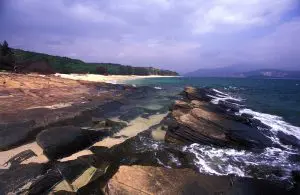Especially during weekends and public holidays, booths by Sai Kung public piers offer an array of boat tours to nearby islands and scenic coastlines. While longer excursions to view the Geopark’s volcanic rock formations are tempting, there are options for short rides that are also rewarding and stay within the natural harbour of Port Shelter, so should be tranquil even when choppy seas beyond make for bouncy boat rides.
Two of the best places to head, which you can readily combine in a day, are Sharp Island – named for its angular shape, and Yim Tin Tsai, an islet with a village revitalisation project.
Yim Tin Tsai decline and rebirth
On a map, Yim Tin Tsai is little more than a blob of land by the northwest coast of far larger Kau Sai Chau. At just over 500 metres across, and with the highest point a mere 37 metres above sea level, it could be easily overlooked as somewhere to visit.
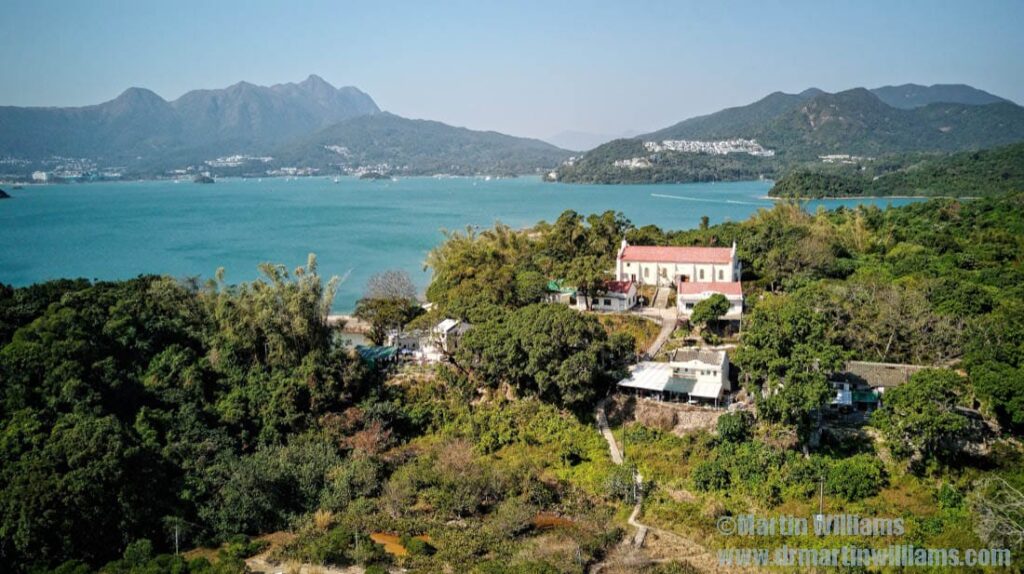
Yet even as the village ferry arrives at the pier from Sai Kung, Yim Tin Tsai looks interesting, with a gleaming cream, traditional style two-storey house by the jetty, another renovated two-storey house, with small square windows in its whitewashed main wall, along a path to the village, and a white-walled chapel topped with a cross, set prominently above a wooded slope. There are a couple of outdoor restaurants in view, too: Yim Tin Tsai is no fusty museum, but a vibrant locale when visitors arrive.
The village is small, and was never home to more than around 200 people, according to Centennial Historic Yim Tin Tsai, Sai Kung, Hong Kong, published by the Chinese University of Hong Kong Centre for Catholic Studies [well, didn’t see it completely specific about number, just a mention of population increasing to perhaps just over 200 by 1950s, after which decline].
Yim Tin Tsai’s history is akin to several other villages in the more remote areas of Hong Kong – settled by members of a Hakka clan [surnamed Chan, in case of interest] who arrived in Hong Kong from southern China after 1670, and nurturing a community that remained until the 1950s and onwards, which saw families moving out in search of a better life, until by the late 1980s there were just four residents and, by the turn of the century, no one remained.
But Yim Tin Tsai was notable as during the late 19th century, villagers embraced Catholicism, as European missionaries spread the faith in the Sai Kung area from 1865; they were influenced by friends in Sai Kung, and were likewise more accepting of foreign influence than some Hong Kong people, along with maybe desiring education for their people, and welcoming some support against the Puntei ethnic group, members of which pushed for land rents they believed were owed. At one point, a group of Puntei arrived to collect rent and eradicate Christianity from the Sai Kung region, and, as the Centennial History notes, Father Volunteri led his flock, armed with pitchforks and pikes, against them. St Joseph’s Chapel was built early last century, and became a centre for celebrating Christmas and Easter. As the village was abandoned, it fell into disrepair, yet former residents still returned, especially for an annual feast. In 2004, the Hong Kong Diocese renovated the chapel, initiating a renaissance for Yim Tin Tsai.
St Joseph’s Chapel and stained glass windows
Former residents began cooperating in revitalising Yim Tin Tsai, through a project now run by an NGO grandly titled The Salt & Light Preservation Society. While there are still ruined houses, others have been renovated to look spick and span, their exteriors enlivened with fresh coats of paint. So far, only two people have become new residents, with others arriving during weekends and public holidays to operate small restaurants, and volunteer in guiding visitors.
The former school is among the restored buildings, its interior now hosting an exhibition of paraphernalia from the past.
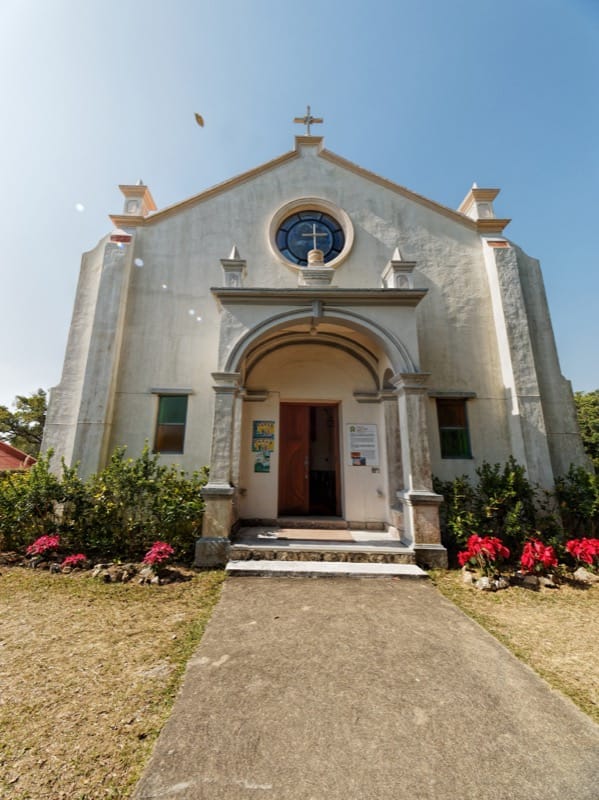
Just above it stands the chapel, a solidly built building with a rectangular layout, topped with a simple gable roof. In 2005, it received a UNESCO Award of Merit for cultural heritage conservation. The walls are painted white both inside and out, and behind the altar is a tiny alcove with a statue of St Joseph holding the baby Jesus, flanked by red and white decorations. High in the opposite wall, a circular stained glass window colourfully portrays the adult Jesus with a priest.
Some houses also have stained glass windows. One of these features a scene before a traditional wedding, with the bride-to-be having her face smeared with ash to show the villagers will miss her: a local custom, apparently.
Salt pans and a woodland trail
Below, there’s a low, level area of old salt pans. Yim Tsin Tsai means “small salt pans”, and during the 19th century the village was a major supplier of salt to Sai Kung Town. As salt became readily available in stores, the pans fell into disuse. Yet here, too, there is renovation work underway, making Yim Tin Tsai the only place in Hong Kong that currently produces salt.
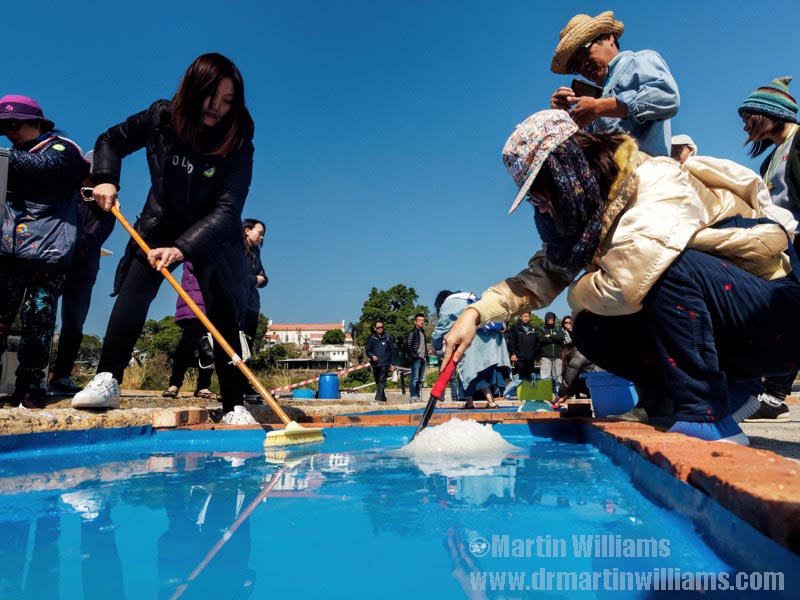
A section of new salt pans has been created, using concrete for surfacing. Eventually, says ?? [will check his name; guy running salt making workshop]] the aim is to produce small amounts of salt for sale, but today there are mainly just workshops for visitors, allowing a glimpse of times before salt became readily available in stores.
During a recent demonstration of salt making, sea water had been exposed to wind and sun until the salt crystals formed; watched by an instructor, visitors enthusiastically swept it into small piles.
A footpath from by the salt pans leads southwards to pass an inlet with mangroves, and a causeway to Kau Sai Chau. The path runs through woodland, emerging at one point where a pavilion affords a fine view of the village with Ma On Shan as a backdrop. Then, it curves gently downhill, leading near an old well before passing houses, with the pier close by.
Beach to beach hike on Sharp Island
While Sharp Island (Kiu Tsui Chau) is over two km long, its steep terrain has largely defeated attempts at establishing rural communities; a couple of decades ago I saw the remnants of a hamlet on the west coast, but nowadays there’s just a new house barely visible within its own grounds ringed by a tall fence – a little like one of the opulent residences near Shek O on Hong Kong Island. But it’s still popular with visitors who enjoy the scenery, and beaches, including one of Hong Kong’s few dog friendly beaches . Boat operators serve two beach areas on the west coast, and a trail makes for a scenic walk between them.
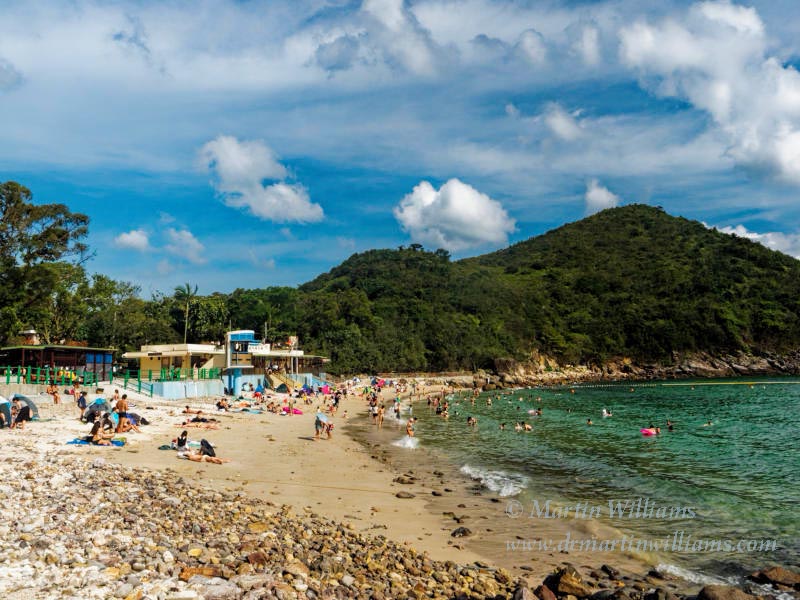
Perhaps head first to the beach at Hap Mun Bay (Half Moon Bay), close by the island’s southernmost tip. While it may become crowded on fine summer days, in winter it might be so deserted you can stroll on the sand, making footprints like Robinson Crusoe.
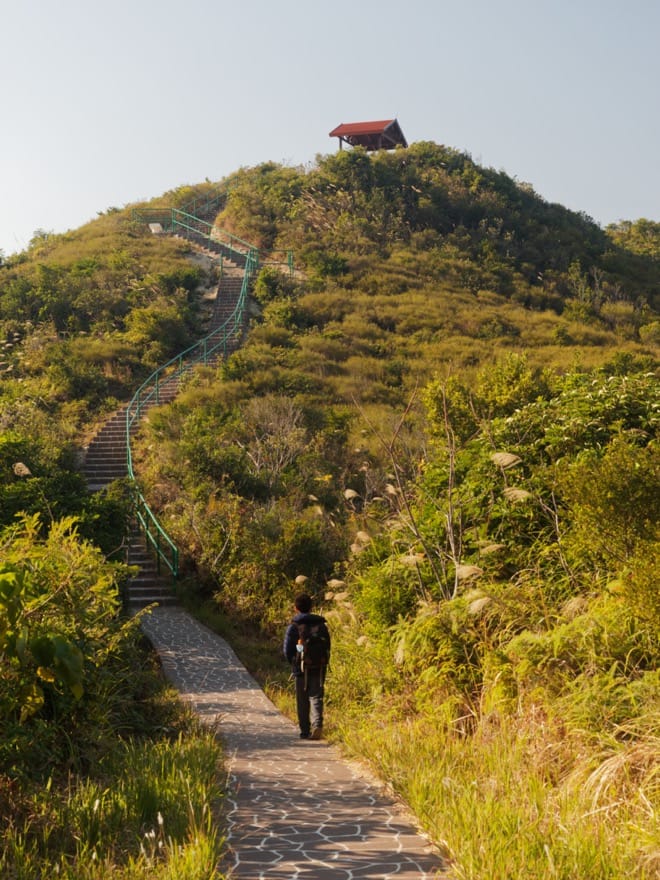
From here, the trail heads up the ridge at the heart of the island. There are splendid views during the walk – down to the bay with its relatively pristine water, westwards to the Clearwater Bay Peninsula, and east over the rolling landscape of Kau Sai Chau, with golf course fairways amidst scrubland and woodland. This is also a good place to watch for white-bellied sea-eagles, which sometimes breed nearby.
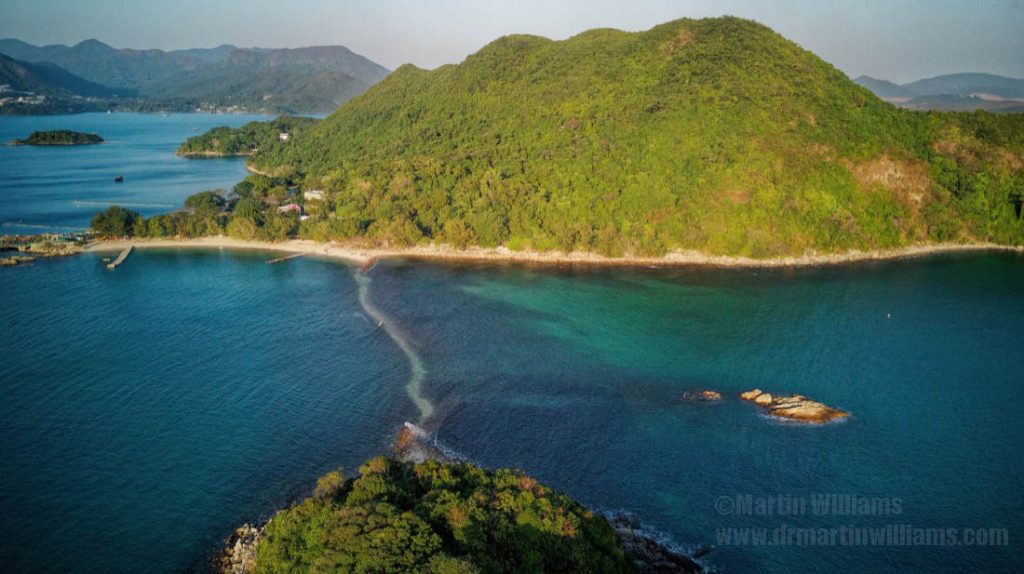
The path runs along the crest of a ridge, but rather than climbing the higher hill to the north, it drops down to the west, into woodland. There are flights of steps, and the path emerges by the shore at Kiu Tsui, which has only a small beach but in winter is more popular than Hap Mun Bay.
An attraction here is a tombolo – a slender ribbon of rocks and sand between Sharp Island and Kiu Tau, a neighbouring islet. Until recently, it was easy to walk along this at low tide, but lately it seems the sand and rock still remains covered even as the tide falls – maybe because it was eroded by storm surge and waves from Typhoon Hato last August.
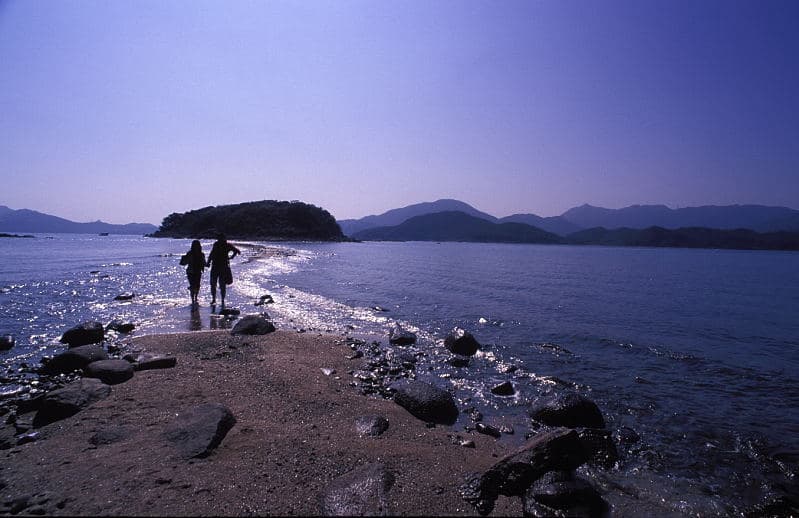
Even when the tombolo is covered this is a pleasant place to relax, admiring islands, sea and hills, before returning to Sai Kung. If it’s late afternoon, check the skies over Yeung Chau when nearing the pier, as there may be tens or hundreds of black kites gathering before they go to roost on the island.
Getting there
There’s a booth for the Yim Tin Tsai ferry, perhaps at the western end of the row of booths at Sai Kung waterfront. For more information on the revitalisation project, visit 關於 鹽光保育中心 (Chinese only). There are three or more small restaurants with outdoor seating, offering local fare including baked chicken, along with terriyaki or more at Cafe de Yim Tin by the pier.
Several booths along Sai Kung waterfront offer sampan and/or speedboat trips to Sharp Island, among other places. You can book a return trip for perhaps HK$50-80, arranging to be dropped off at Hap Mun Bay, and collected at Kiu Tsui – check the return times, and ways to identify boats from the company you book with.















